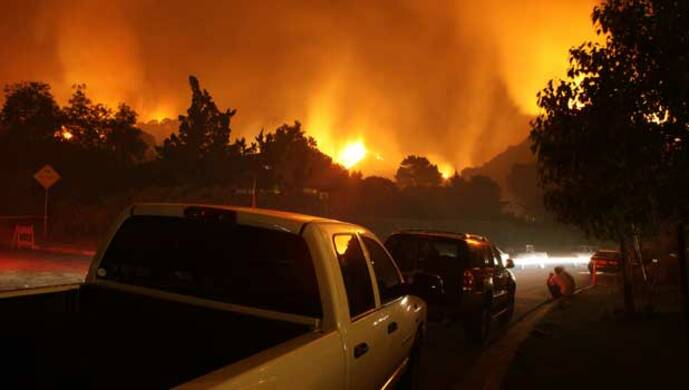watch the REskill masterclass:
COP 28 sees the very first global stock take, whereby the participants take inventory of where Earth stands with regards to mitigation, adaptation and finance.
Essentially, this inventory takes a measure of where we stand with regards to the three key objectives of the Paris Agreement where they were instigated. It’s a long technical process of collecting, analyzing and summarizing information, such as, for example, in the Emissions Gap report by the UNEP, etc. The global stock take tells us essentially where the world stands collectively with regards to the climate objectives. We are heading to something like 2.9° C warming by the end of the century if all unconditional NDCs are implemented, so we're really missing the objectives of the Paris Agreement. And then if all net zero pledges are implemented, which is a big if, then we're heading to something like 2°C warming by the end of the century.
We are heading to ~2.9° C warming by the end of the century instead of the 2°C objective, but we were heading to 3 1/2°C at least before the Paris Agreement.
Now, one can argue, we're really off track and it's true. However, one should also remember that before the Paris Agreement, we were actually heading to something like 3 1/2°C or more of global warming. So, we cannot say that nothing was achieved. We really shaved off half a degree or even more from the temperature projections, but it's still not enough, definitely far from enough to achieve the objectives set out in Paris. Right now, the outcome of the global stock take may be either a binding COP decision to increase ambition or a weaker political declaration, and we will see how it's going to unfold in Dubai.
Two other important topics being discussed at COP28, are climate finance and adaptation.
The 100-billion-dollar annual climate finance target was set out in the Copenhagen COP in 2009. According to official numbers, this climate finance target is going to be finally achieved in 2023, but there are a lot of observers who actually question the official numbers and say that even those official numbers are grossly overestimated. The new target on climate finance is going to be adopted next year, but hopefully this year at COP28, we're going to advance the discussions. This target will need to reflect the increasing financial needs of developing countries to respond to already occurring climate change.
Another important topic being discussed at COP28, indeed, is related to adaptation, and loss and damage. There are a lot of open questions regarding how we actually measure progress on adaptation and most importantly, how we mobilize enough finance, which is currently lacking severely for adaptation. The loss in damage fund is something that was agreed at the last COP. However, the nitty gritty and all the modalities of how this fund is going to function are something that must be ironed out at in Dubai. Progress on this topic was in fact achieved already on the first day of the COP.
To conclude: can we realistically expect to reach an agreement? In the best-case scenario, we're going to have the conclusion of the global stock take with a strong COP decision on ambition raising. Hopefully we're going to see an agreement on the loss and damage fund and funding arrangements, and a meaningful progress on the new collective climate goal.
There are some crucial discussions going on in the sidelines of COP 28.
Yes, they are related to tripling renewable energy, and doubling energy efficiency by 2030. Of course, phasing out fossil fuels is also an important topic, as we’ve seen from the first days of this summit. Here, there will continue to be very heated discussions and many countries will keep pushing for watering down of the language around fossil fuel phase out in the COP decision.
Three reasons why we need a multilateral response to climate change.
There are several factors that that we have to consider here. First of all, when we talk about climate change, we're dealing with the global public goods issue. The atmosphere is a global public good and everybody's using it. Every ton of CO2 emitted anywhere in the world is going to end up in the atmosphere eventually, contributing to global warming. So, a unilateral action by one single country or even a group of countries is not enough unless we have everybody on board.
Now, another factor that we have to consider is that we live in a globalized world, in a global competition and we are facing the issue of what we call carbon leakage. So, for example, if a given country implements very stringent climate policies, it may see the production of carbon intensive industry move overseas. Or we may also see carbon leakage through trade. This is why, for example, the European Union is now introducing the carbon border adjustment.
Another important factor to consider is the issue of equity. Those countries that are most responsible for climate change due to their historical missions are not those who suffer the most, and it's very important when we discuss climate change to give voice to those that are particularly affected. And this is another reason why we need a multilateral process to deal with climate change.
Three principles underlying these international summits
The first one is the so-called precautionary principle. What the precautionary principle tells us is that the uncertainty that we have about climate science should not preclude climate action. In other words, we have to take a cautious approach in the face of such an existential threat as climate change.
The second important principle is the so-called principle of common but differentiated responsibility. What it says is that essentially all countries and all greenhouse gas emissions around the world contribute to global warming. But some countries bear greater historical responsibility because they emitted more in the past and hence are responsible for the current concentration of greenhouse gas emissions. Therefore, these countries have to act faster and more decisively.
And finally, there is the principle of the right to economic development. Now what the principle means is that essentially no international treaty or agreement on climate change should preclude a given country from, pursuing its development goals. And this is, of course, a very important principle for the emerging economies and countries that are still developing.
Why the Paris Agreement was such an important treaty on climate
Well, first of all, the Paris Agreement was the first treaty where we had a concrete objective in terms of limiting global warming. The Paris Agreement says that we should limit global warming well below 2°C compared to pre industrial times with efforts made to limiting it to 1 1/2°C. And in order to achieve that goal, we have to reach Net Zero greenhouse gas emissions some time in the second half of the 21st century. In addition to this temperature and emissions objective, which we usually call mitigation, the Paris Agreement has two additional pillars, one related to adaptation and the other to finance. We know that with the global warming that's already occurring, there will be a lot of adaptation needs and improving resilience of affected communities and affected countries around the world, hence the second pillar related to adaptation. And, finally, there is the crucial third pillar, which is related to finance. How do we finance our mitigation and adaptation objectives? And here the Paris Agreement in its famous article 2.1C says that essentially, we have to align all financial flows with low carbon and climate resilient development.
Now, what's interesting with the Paris Agreement is how the international climate regime evolved from more of a top-down system to a bottom-up system with some top-down elements still included. Here, I would argue that it's important to recognize that there is a trade-off between participation and stringency of the agreement. We've seen with the Kyoto Protocol and the failure in Copenhagen, that if you try to impose stringent targets on countries, your participation is going to suffer. The Paris Agreement with its inherent flexibility allowed us for the global participation as almost all countries around the world participate in the Paris Agreement. We can say that we exchanged stringency for global participation and it's an open question whether it was a good or bad idea. But what we did achieve was the participation of all countries.
Now at the heart of the Paris Agreement, there is this bottom-up approach. What does that actually mean? Essentially under the Paris Agreement, every country is free to define its own climate strategy and its own emission reduction objectives under what we call nationally determined contributions or NDCs. These are strategic documents that every country has to present internationally and has to revise every five years. The last revision cycle was in 2020 and the next one is in 2025. And the idea here is that while we know that the initial set of NDCs when we put them together is not sufficient to put us on track to 2°C, let alone 1.5°C trajectory, but the Paris Agreement incorporates what we call a ratchet mechanism. The ratchet mechanism essentially says that the revision of every NDC has to increase ambition. So, every new NDC that the country presents has to have more ambitious emission reduction targets and industrialized countries must have quantified targets, whereas developing countries have to move over time towards having absolute quantified emission targets.
The COP has been plagued by what is seen by some as a conflict of interest: the UAE controls around 6% of the world's oil reserves. How this manifested itself during the 12-day summit.
First of all, one needs to understand that the location of the COP rotates according to the UN system. So, at some point, a COP has to take place in the Middle East. On a positive note, I would say that the UAE is probably one of the more advanced countries in the Middle East on climate, as they've invested quite heavily in renewable energy. Secondly, there's no place probably on Earth that you couldn't criticize. For example, the United States is the biggest oil producer in the world. But I'm sure there wouldn't be such an amount of criticism if this COP was taking place in the United States.
Let’s be cautious about the solutions typically promoted by the oil & gas industry, such as carbon capture and storage.
That said, I think the bigger controversy is not the location itself, but the presidency of this year’s COP. The President is the Minister of Industry, Sultan Obaid Khaleefa Al Jaber Al Marri. He also happens to be the CEO of Abu Dhabi oil and gas company, Al Jaber. So, there is a valid question on the conflict of interest. This brings me to the question of the fossil fuel lobby. There was a record number of fossil fuel lobbyists at the last COP in Sharm El Sheikh (and this record has been beaten at COP28, ed.) and there is a question of whether the whole process is actually being captured by the fossil fuel lobby. I would say that there is probably an influence, and we need to closely monitor this.
It’s not only the problem of the COP itself, I think it’s the problem of climate policy in general. The fossil fuel industry’s major oil and gas companies are planning only around 2% of their investments on renewables, so they are clearly betting against the energy transition. We therefore have to be very cautious about the solutions that the oil and gas industry is typically promoting, such as carbon capture and storage.





